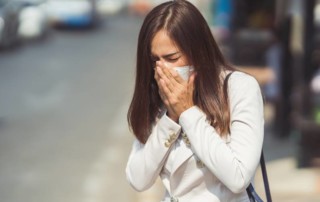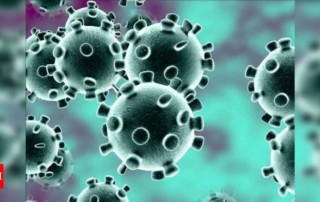COVID-19
UNIC Coronavirus Health and Research Portal
On Coughing and Airborne Droplet Transmission to Humans
Talib Dbouk and Dimitris Drikakis
University of Nicosia, Nicosia, Cyprus
The recent COVID-19 pandemic prompted the need for deeper understanding of the transport of fluids and droplets emanating from our respiratory tracts when we cough, sneeze, speak or breathe. The droplets transport will influence the spread of coronavirus and determine the implementation of guidelines about social distancing, mask wearing, crowded gatherings, as well as everyday practices of social behaviour in private, public and business environments.
The results of our research showed that in open spaces, airborne droplets carriers can travel significantly further than the 2 meters recommended distance due to the wind speed. The issues arising from the past and recent pandemic require a holistic approach to elucidate the open scientific questions and address the practical challenges. Such an approach would require closer interaction between bio-medicine, engineering fluid physics, and social sciences.
Figure 1
Saliva droplet cloud kinematics show the diameter of the droplets resulting from a human cough. Larger droplets settle more rapidly than smaller ones due to gravitational forces. The wind speed is approximately 0 km/h. The total mass of ejected saliva is 7.7 mg, with 1008 total number of droplets. The environment is at ambient temperature, pressure, and relative humidity of 20 oC, 1 atm, and 50%, respectively, with the ground temperature at 15 oC. The droplets in the figure have been scaled up for visualisation purposes.
Figure 2
A human cough: saliva droplet’s disease-carrier particles emanating from coughing do not travel more than 2 m in space at approximately zero wind speed. The environment was considered to be at ambient temperature, pressure, and relative humidity of 20 oC, 1 atm and 50% with the ground temperature at 15 oC.
Figure 3
Saliva droplets can travel large distances, depending on environmental conditions such as wind speed, temperature, pressure and humidity. Wind shown blowing left to right at speeds of 4 km/h (top) and 15 km/h (bottom) can transport saliva droplets up to 6 meters. The droplets in the figure have been scaled up for visualisation purposes.
What Does This Mean?
- In open spaces, airborne droplet carriers can travel significantly further than the 2m recommended distance depending on the wind speed and the environmental conditions. The above is an important finding and Citizens and policy-makers should be aware of it.
- If a person is in the path of the virus cloud, the risk of infection will, most likely, depend on the dosage and time of exposure. Therefore, it is crucial to better understand which scenarios may allow the transmission at longer distances. The present study contributes to advancing the above understanding.
- The dosage and time needed for an infection is still under study and may vary from one person to another. Further research and closer interaction between bio-medicine and engineering fluid physics are necessary to understand the conditions under which patients are being infected.
Non-Technical Summary
The recent COVID-19 pandemic prompted the need for deeper understanding of the transport of fluids and droplets emanating from our respiratory tracts when we cough, sneeze, speak or breathe. The droplets transport will influence the spread of coronavirus and determine the implementation of guidelines about social distancing, mask wearing, crowded gatherings, as well as everyday practices of social behaviour in private, public and business environments.
When sneezing or coughing, larger droplets are formed by saliva, and smaller droplets by mucous coating of the lungs and vocal cords. The smaller droplets are often invisible to the naked eye. Past research has shown that most respiratory droplets do not travel independently on their trajectories. Instead, droplets in a continuum of sizes are trapped and carried forward within a moist, warm, turbulent cloud of air. Although the mechanisms of virus transmission are still under debate, it is widely accepted that aerosol or respiratory droplet transmission is the critical factor for the rapid spread and continued circulation of viruses in humans.
We think that it is likely the dosage and time of exposure which determine whether or not infection will finally occur. Therefore, it is crucial to decide on the scenarios that will allow the transmission to longer distances. Our study aimed at advancing the understanding of the transfer of airborne particle carriers to humans through advanced coupling between droplets and fluid flow modeling and simulation.
The initial modeling configuration of the problem takes into account several parameters that can influence the simulation, including the wind speed in an open environment.
An accurate prediction of the transfer of airborne particle carriers to humans from a cough is governed by the following modeling considerations that must be taken into account:
- The saliva droplets initial size distribution at the onset of the coughing event.
- The human mouth-print of the cough.
- The period of the cough and its intensity (or initial saliva droplets speed).
- The numerical modeling approach to capture the complex varying space and time scales, e.g. both heat and mass transfer considerations, modeling of mass and phase changes due to droplets evaporation, coalescence, break up and turbulent dispersion in interaction with the bulk flow field.
The computational domain in the simulation is a grid in front of the coughing person . The analysis involved running partial differential equations on 1008 saliva droplets and solving approximately 3.7 million equations in total.
Our findings showed that, when a person coughs, the wind speed in an open space environment significantly influences the distance that airborne disease-carrier droplets travel.
- Without surrounding wind speed, the droplets will fall to the ground in a short distance from the person exhaling or coughing. The present analysis shows that the range may not exceed one meter (See Figure 2). A tiny number of particles may travel slightly further longer. Still, their trajectory beyond one meter will already be at a height significantly below half a meter dropping towards the ground. Thus, these droplets may not constitute a risk regarding facial contact of adults at this distance.
- At wind speeds from 4 to 15 km/h, we found that saliva droplets can travel to distances up to 6 meters with decreasing concentrations and liquid droplets size in the wind direction (see Figure 2). Our findings imply that depending on the environmental conditions, the 2 meters social distance may not suffice. Further research is required to quantify the influence of other parameters such as the environment relative humidity and temperature amongst others.
- The droplets cloud will affect both adults and children of different heights. Shorter adults and children could be at higher risk if they are located within the trajectory of falling droplets.
- At a lower wind speed, the droplet total mass reduction occurs more slowly compared to a higher speed, which may prolong the exposure of a human to the droplets if the subject is located within the droplets envelope.
Overall, the results showed that in open spaces, airborne droplets carriers can travel significantly further than the 2 meters recommended distance due to the wind speed. The issues arising from the past and recent pandemic require a holistic approach to elucidate the open scientific questions and address the practical challenges. Such an approach would require closer interaction between bio-medicine, engineering fluid physics, and social sciences.
Figure 1
Saliva droplet cloud kinematics show the diameter of the droplets resulting from a human cough. Larger droplets settle more rapidly than smaller ones due to gravitational forces. The wind speed is approximately 0 km/h. The total mass of ejected saliva is 7.7 mg, with 1008 total number of droplets. The environment is at ambient temperature, pressure, and relative humidity of 20 oC, 1 atm, and 50%, respectively, with the ground temperature at 15 oC. The droplets in the figure have been scaled up for visualisation purposes.
Figure 2
A human cough: saliva droplet’s disease-carrier particles emanating from coughing do not travel more than 2 m in space at approximately zero wind speed. The environment was considered to be at ambient temperature, pressure, and relative humidity of 20 oC, 1 atm and 50% with the ground temperature at 15 oC.
Figure 3
Saliva droplets can travel large distances, depending on environmental conditions such as wind speed, temperature, pressure and humidity. Wind shown blowing left to right at speeds of 4 km/h (top) and 15 km/h (bottom) can transport saliva droplets up to 6 meters. The droplets in the figure have been scaled up for visualisation purposes.
The University of Nicosia (UNIC)
About the University of Nicosia
The University of Nicosia (UNIC) is the largest university in Cyprus, and the largest university in southern Europe that teaches primarily in English, welcoming 12,000+ students from over 70 countries worldwide. The University of Nicosia is a comprehensive university with 6 schools, 20 departments and over 100 degree programs offered on-campus and online.
The University of Nicosia is best known in the fields of medicine, law, blockchain, accounting, education, forecasting and international relations and for a series of partnerships with other leading European universities. UNIC was most recently ranked #106 in its region by QS and #300 to #400 globally in the Times Higher Education Impact rankings.
To learn more about the University of Nicosia, please see: https://www.unic.ac.cy/
UNIC’s COVID-19 Response
University of Nicosia faculty across a variety of academic disciplines are actively engaged in research and analysis and serving in scientific / public policy roles supporting the global COVID-19 response.
For more information about the University of Nicosia’s work relating to COVID-19 including potential collaboration, please see: https://www.unic.ac.cy/coronavirus/
Contact Information
For more information about this study, please contact Prof Dimitris Drikakis at [email protected].
For more information on our COVID-19 related research in general, please contact UNIC at [email protected].
Press Coverage
Articles and press mentions in global media about the research.
La tos repetitiva degrada gravemente la eficacia de las mascarillas
La tos repetitiva degrada gravemente la eficacia de las mascarillas Cada vez más investigaciones científicas apuntan a la eficacia de las mascarillas Al idéntico que tratamiento de freno del nuevo coronavirus. Aunque, existen menos estudios acerca de cómo se degradan con el manipulación, A pesar de que mucha gente las reutiliza en varias oportunidades, incluso por arriba de su vida útil. Por ello, un Equipo de la Universidad de Nicosia (Chipre) termina de publicar en «Physics of Fluids» unas conclusiones [...]
Καθ. Δρικάκης: Γιατί τα 2m δεν προστατεύουν επαρκώς από COVID19
Καθ. Δρικάκης: Γιατί τα 2m δεν προστατεύουν επαρκώς από COVID19 Παγκόσμια αίσθηση προκαλεσε η μελέτη ερευνητών του Πανεπιστημίου Λευκωσίας, που δημοσιεύθηκε στο επιστημονικό περιοδικό Physics of Fluids. Η εν λόγω έρευνα καταδεικνύει ότι οι τρέχουσες οδηγίες του ΠΟΥ για την κοινωνική απόσταση των 2 μέτρων που εφαρμόζονται σε όλα πλέον τα κράτη για προστασία από τον κορωνοϊό, μπορεί να είναι ανεπαρκείς, διότι ένας ήπιος βήχας σε συνδυασμό με χαμηλές ταχύτητες ανέμου 4-15 km/h (ένα ελαφρύ αεράκι δηλαδή) είναι δυνατό να [...]
Καθ. Δρικάκης: Γιατί τα 2m δεν προστατεύουν επαρκώς από COVID19
Καθ. Δρικάκης: Γιατί τα 2m δεν προστατεύουν επαρκώς από COVID19 Παγκόσμιο ενδιαφέρον για έρευνα του Πανεπιστημίου Λευκωσίας που αμφισβητεί ουσιαστικά την επάρκεια των 2 μέτρων για προστασία από τον COVID19 Δείτε σχετικά γραφήματα Συνέντευξη του Καθηγητή του Πανεπιστημίου Λευκωσίας Δρ Δημήτρη Δρικάκη στην offsite Παγκόσμια αίσθηση προκαλεσε η μελέτη ερευνητών του Πανεπιστημίου Λευκωσίας, που δημοσιεύθηκε στο επιστημονικό περιοδικό Physics of Fluids. Η εν λόγω έρευνα καταδεικνύει ότι οι τρέχουσες οδηγίες του ΠΟΥ για την κοινωνική απόσταση των 2 μέτρων [...]
Coronavirus: ¿cómo deberá distanciarse la gente en las plazas para evitar contagios? – MisionesOnline
Una nueva investigación elaborada por la Universidad de Nicosia, en Chipre, reveló que al aire libre los fluidos de la saliva viajan a mayor velocidad, por lo que sería mayor la posibilidad de infectarse. Son varios los países de Europa que ya han comenzado a flexibilizar el aislamiento social preventivo y obligatorio debido a que el pico de contagios del virus en lugares como Italia y España disminuyó significativamente. Sin embargo, a pesar de que el nivel de contagios y [...]
Ansteckung: Welche Rolle spielen Aerosole bei der Corona-Infektion?
Ansteckung: Welche Rolle spielen Aerosole bei der Corona-Infektion? Der große Tropfen Nasenschleim sinkt schnell zu Boden, so viel ist klar. Doch das Coronavirus ist winzig und kann in Mini-Tröpfchen auch länger in der Luft stehenbleiben. Diese Aerosole rücken immer mehr in den Fokus der Forschung. Bei der Erforschung von Corona-Infektionswegen nehmen Wissenschaftler zunehmend sogenannte Aerosole unter die Lupe. Damit wird ein Gemisch aus festen oder flüssigen Schwebeteilchen – wie Partikel von Sars-CoV-2 – in der Luft bezeichnet. 1: ad:0 teaser: svn:4 [...]
Six feet distancing not enough to stop virus transmission in light winds: Study
Six feet distancing not enough to stop virus transmission in light winds: Study LONDON: The current physical distancing guidelines of 6 feet may be insufficient to prevent Covid-19 transmission, according to a study which says a mild cough in low wind speeds can propel saliva droplets by as much as 18 feet. Researchers, including those from the University of Nicosia in Cyprus, said a good baseline for studying the airborne transmission of viruses, like the one behind the Covid-19 pandemic, [...]
What role do aerosols play in corona infection?
What role do aerosols play in corona infection? The big drop of nasal mucus quickly sinks to the ground, that much is clear. But the corona virus is tiny and can stay in the air longer in mini droplets. Research is increasingly focusing on these aerosols.When researching Corona infection routes Scientists are increasingly examining so-called aerosols. This is a mixture of solid or liquid suspended particles – like particles from Sars-CoV-2 – in the air. “We are pretty sure that [...]
Coronavirus: a qué distancia deberían permanecer las personas en un parque para no contagiarse
Son varios los países de Europa que ya han comenzado a flexibilizar el aislamiento social preventivo y obligatorio debido a que el pico de contagios del virus en lugares como Italia y España disminuyó significativamente. Sin embargo, a pesar de que el nivel de contagios y fallecidos empezó a reducirse, las medidas preventivas se deben seguir implementando. La Organización Mundial de la Salud (OMS) recomienda un mínimo de un metro de separación entre persona y persona para mantener la distancia social, [...]
Coronavirus: a qué distancia deberían permanecer las personas en un parque para no contagiarse
Son varios los países de Europa que ya han comenzado a flexibilizar el aislamiento social preventivo y obligatorio debido a que el pico de contagios del virus en lugares como Italia y España disminuyó significativamente. Sin embargo, a pesar de que el nivel de contagios y fallecidos empezó a reducirse, las medidas preventivas se deben seguir implementando. La Organización Mundial de la Salud (OMS) recomienda un mínimo de un metro de separación entre persona y persona para mantener la distancia [...]
社会距离:比一米高两米– COVID-19 FACTS
社会距离:比一米高两米– COVID-19 FACTS 关于英国是否应按照世界卫生组织的建议放宽其距离两米的规定,目前仍存在争议,以使某些企业和款待 最新的研究 如何缓解锁定同时防止出现第二个峰值没有简单的答案。这样的研究对于帮助告知这些复杂的决定至关重要。 这种说法的来源是什么? 媒体报道了由世卫组织资助在《柳叶刀》上发表的系统评价。 审查的方法很严格,但是研究结果基于观察研究而受到局限,观察研究不能排除影响结果的其他行为(例如人们洗手的频率)。但是,这是当前可用的最佳证据。 这种说法的依据是什么? 该系统评价包括172项观察性研究,根据身体状况,了解已知感染者与附近感染者(家庭成员,护理人员或医护人员)之间传播SARS-CoV-2和其他类似呼吸道冠状病毒的风险。面罩和防护眼镜的距离和使用。 关于距离的主要结果来自于汇总了其中29项研究的结果(10,736名参与者)。 Read the full article here: 社会距离:比一米高两米– COVID-19 FACTS












